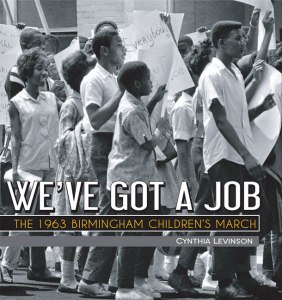Like many people, we are awed by the students of Marjory Stoneman Douglas High School in Parkland, Florida, for taking the lead in America’s ongoing debates over the balance between the right to own guns and the need to control access to them. The students’ grief and outrage over the murders of seventeen of their classmates, teachers, and staff have led to policy changes by corporations that sell weapons, pleas for gun-control legislation at the state and national levels, and plans for #MarchForOurLives demonstrations.
 Their activism follows a long tradition of young people taking charge to change the world.
Their activism follows a long tradition of young people taking charge to change the world.
Cynthia’s first book, We’ve Got a Job: The 1963 Birmingham Children’s March, focuses on four of about four thousand elementary and high school students who protested segregation there. Because they, unlike most adults in the community, were willing to get arrested and go to jail for up to a week, Birmingham ultimately rescinded its segregation regulations. Some kids were even attacked by snarling dogs and hosed by firefighters. (Cynthia’s picture book, The Youngest Marcher: The Story of Audrey Faye Hendricks, a Young Civil Rights Activist, deals with the same events for younger readers.)
 Her next book, Watch Out for Flying Kids: How Two Circuses, Two Countries, and Nine Kids Confront Conflict and Build Community, shows how kids can alter their worlds in other ways besides protesting. Israeli and American, Arab Muslim and Jewish, black and white, upper- and lower-class, English-, Arabic-, and Hebrew-speaking youngsters live the change they want to see by juggling, tumbling, and trampolining together.
Her next book, Watch Out for Flying Kids: How Two Circuses, Two Countries, and Nine Kids Confront Conflict and Build Community, shows how kids can alter their worlds in other ways besides protesting. Israeli and American, Arab Muslim and Jewish, black and white, upper- and lower-class, English-, Arabic-, and Hebrew-speaking youngsters live the change they want to see by juggling, tumbling, and trampolining together.
Fault Lines in the Constitution highlights several young activists.
- Leezia Dhalla came to America legally with her family when she was six years old but unknowingly overstayed her visa. Now, as a Dreamer—an undocumented resident who hopes to become a citizen through the Development, Relief and Education for Alien Minors (DREAM) bill—she works on behalf of others in her predicament.
- College-student Jennifer Gratz of Michigan spearheaded a petition campaign that resulted in a revision to her state’s constitution regarding affirmative action.
- Another college student, Gregory Watson, worked for a decade and managed to get the Twenty-seventh Amendment added to the US Constitution.
Recognizing the powerful role young people can play in political reform, the final chapter of Fault Lines, which explains ways to repair the Constitution, urges students to “Speak Up!”
That’s exactly what the young people in Parkland are doing in regard to gun control. The debate about this issue often focuses on the Second Amendment. Fault Lines addresses the body of the Constitution, rather than the Bill of Rights or other amendments. That’s because the book concerns the problems with the structure of the US government rather than citizens’ rights. Yet, the purpose of our blog is to show the ways that current events relate to the Constitution. And the Second Amendment is certainly a very current and ongoing topic.
Mary Ann Cappiello developed terrific Teaching Ideas for Fault Lines, including a Critical Literacy component that connects the book with the Second Amendment. The link is here. With her permission, we are reposting this section.
Rights and Responsibilities: The Right to Bear Arms. Perhaps no amendment may be as familiar to your students than the Second Amendment, given the national debate about gun rights and responsibilities and the epidemic of gun violence. In the week in which this blog entry was written, seventeen students and teachers were murdered at Marjory Stoneman Douglas High School in Parkland, Florida. After finishing Fault Lines, have students read the text of the Second Amendment as well the interpretation, and the “Matters of Debate” section on the Constitution Center’s interactive site. In small groups, have students create a timeline of the debate. Next, have students explore gun violence statistics in the United States as presented by a range of sources: The National Rifle Association (NRA), The Brady Center, The National Center for Gun Rights, and Everytown for Gun Safety. Next, have students explore the pros/cons on gun rights and responsibilities as presented by ProCon.org. Finally, have students look at the statistics compiled hourly by the Gun Violence Archive, a non-partisan, non-profit organization. Finally, have them read and watch what some of the students from Douglas High School are saying this week. To what extent is our epidemic of gun violence connected to other challenges faced by our country, such as a lack of access to mental health services and the opioid crisis? What do your students think should happen next? What, if any, laws should be created?


No problem. When it goes live tomorrow or Thursday, I’ll ask you to add a link to YouthInFront where I’ll have a YouTube video on youth activism and the kids in Birmingham. Stay tuned!
>
LikeLike
Please visit supremejinx.com on WordPress.com Thank-you ,
Cammy Frazier
LikeLiked by 1 person
DAFA–a very interesting idea!
LikeLike
This informative post reminds me of this Family Guy episode: https://www.youtube.com/watch?v=RpeUznIhgLU. Thanks for your post!
LikeLiked by 1 person
Hilarious! Thank you for responding.
LikeLike
Today, March 24, 2018, the earlier promised March for Life by surviving students of the St. Valentine’s Day slaughter at the Parkland school in FL is taking place in many cities in America, including in Washington, DC. Meantime, President Trump is celebrating another weekend by playing golf at one of his Trump Enterprises resorts. “Fore!” But be “Fore-warned,, these teenagers will soon be able to vote.
LikeLiked by 1 person
Good point, Shag.
LikeLike